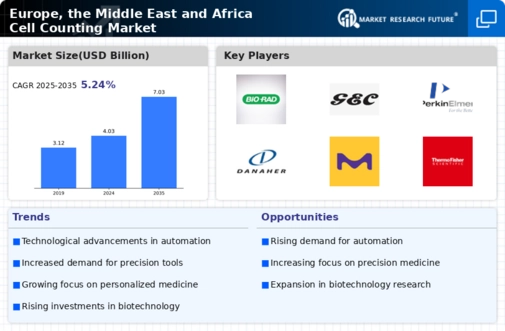Market Trends
Key Emerging Trends in the Europe Cell Counting Market
One of the prominent trends in the EMEA Cell Counting Market is the continuous evolution of automated cell counting technologies. These advancements contribute to enhanced accuracy, efficiency, and speed in cell counting processes. Automated systems are becoming increasingly popular in research and clinical settings, addressing the growing demand for reliable and quick cell analysis. The EMEA region is experiencing a growing focus on cancer research, leading to an increased demand for precise cell counting solutions. Cell counting plays a crucial role in cancer studies, including drug development and personalized medicine. As a result, there is a notable surge in the adoption of specialized cell counting technologies tailored for cancer research applications. Stem cell research has been steadily gaining traction in Europe, the Middle East and Africa. The flexibility of stem cells in regenerative medicine and therapeutic strategies is promoting the requirement for precise cell counting methods. The adoption of stem cell analysis-related specialized cell counting solutions is on the rise and this trend has gained prominence in EMEA Cell Counting Market. In the EMEA region, biopharmaceutical sector has recorded significant development with many new biologicals coming into market. Biopharmaceuticals, including monoclonal antibodies and recombinant proteins are becoming more prevalent as a result of production. This growth greatly increases the requirement of cell-counting technologies that are used in bioprocessing and quality control. Artificial intelligence (AI) is being adopted in the cell counting process. Cell counting systems powered by artificial intelligence eliminate manual image analysis and interpretation, thus reducing the time taken to process data as well as enhancing accuracy. This trend is significantly contributing to the development of cell counting technologies in terms of capabilities, especially across EMEA. In clinical settings, there is an obvious focus on point-of-care cell counting solutions. Cell counting devices that are light, easy to use and offer fast cell analysis at the point of need continue gaining popularity. This trend is fueled by the fact that there are numerous applications in clinical diagnostics and patient management where real-time cell counting results which this technique provides, are very much necessary. Key players in the EMEA Cell Counting Market are actively engaging in collaborations and partnerships to broaden their product portfolios and geographical reach. Collaborative efforts between technology providers and research institutions or pharmaceutical companies are fostering the development of innovative cell counting solutions and contributing to market growth. The ongoing COVID-19 pandemic has underscored the importance of cell counting in various aspects, including vaccine development and virus research. The urgent need for accurate cell counting in these critical areas has led to an increased demand for cell counting technologies in the EMEA region. This impact is likely to have lasting effects on the market, emphasizing the role of cell counting in public health emergencies.









Leave a Comment